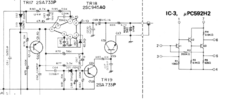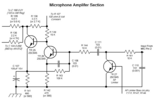You will have to see if the clicking is from the input, from Mic Gain TO the mic amp IC is too much for the IC to handle - an input cap of 0.1uF (C69) - make sure it's fresh.
Why I say that? There were several mods and ways to bring more signal in to the mic amp - one was to raise the capacitance of the input cap - C69 from a 0.1uF to a 1uF - which can make the Mic amp unstable and squeal - or even clip.
It's also why I mention checking the output cap of TR24 - the 8V regulator - any sags in key up will also reduce the ability to even amplify the mic signal - so if the amp draw was too much for TR24 - the mic amp starts to clip.
Why I say that? There were several mods and ways to bring more signal in to the mic amp - one was to raise the capacitance of the input cap - C69 from a 0.1uF to a 1uF - which can make the Mic amp unstable and squeal - or even clip.
- It didn't matter how much signal - just that the input capacitance level that the mic amp inputs could use, was only so much before it became unstable and unusable because of too much drive or an unbalanced input condition like XLR versus 600Ω impedance elements - the dynamics between the two affect how the signal can even be transferred - let alone amplified.
It's also why I mention checking the output cap of TR24 - the 8V regulator - any sags in key up will also reduce the ability to even amplify the mic signal - so if the amp draw was too much for TR24 - the mic amp starts to clip.


